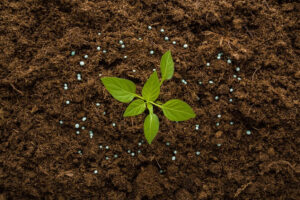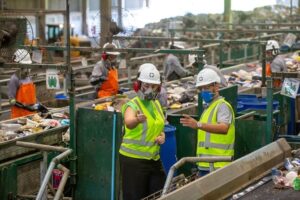WHAT is SOLID WASTE?
When thinking about garbage, it is important to remember that it is something that is generated every day, both by people in their homes or at work, as well as by schools, companies, industries etc. At home, on a daily basis, garbage is generated from product packaging, food scraps and bathroom garbage (Recyclable Waste, Organic Waste and Rejects respectively).
Households are considered small generators (producers) of garbage. In medium and large generators (companies, schools, hospitals etc.), more materials are incorporated into this waste. Some are inert (debris), and others are dangerous (syringes and sharp objects), requiring an identification, in accordance with the current legislation, between Hazardous Waste (Class 1) and Non-Hazardous Waste (Class 2).
Thus, solid waste is nothing more than the waste that human society produces. However, when using the term “waste,” we are also consider all the energy that is still present in the material, and that has not yet been used. When we say “solid waste” instead of “garbage,” it means thinking about the energy optimization of the raw material used, through an adequate way of disposing of the material, through the collection, disposal and processing of all parts (solid, liquid and gaseous) that are produced in the solid waste management cycle.
SOLID WASTE WORLDWIDE
It is estimated that some 1.3 billion ton of Urban Solid Waste (“RSU”) is generated worldwide per year, which means that each person produces approximately 1.2 kg of waste per year. Analyzing a little deeper the generation of waste and its geographic distribution, it is also possible to relate waste to economic development in a way that the greater the economic power of a country is, the greater its production of waste will be.
Comparing the production of solid waste with the current consumption pattern, a great disparity can be noticed. Research developed between the World Bank and the UN predicts an increase of 70% in waste generation, reaching 3.4 billion tons per year in 2050, if we do not change consumption paradigms.
SOLID WASTE IN BRAZIL
In Brazil, according to a study by the Brazilian Association of Public Cleaning and Special Waste Companies (“ABRELPE”), in 2020, 85.5 tons of Urban Solid Waste (“RSU”) were produced, which means 225,965 tons of waste generated each day, with each Brazilian producing an average of 1.07 kg per day. In an ABRELPE projection, Brazil is seen as the largest generator of Urban Solid Waste (“RSU”) in Latin America and the Caribbean, with an estimate of reaching 100 million tons in 2030, if it does not review its production and waste management.
In terms of the country’s regions, the ones that most contribute to this picture are the Southeast (49.7%), Northeast (24.7%) and South (10.8%), followed by the regions that generate less waste, the Midwest (7.5%) and the North (7.4%), confirming that the economic development is linked to higher waste generation.
COLLECTION AND DISPOSAL
In dealing with solid waste, it is essential to consider other aspects as well, in addition to the volume of waste generated. According to the Overview of Solid Waste in Brazil 2021, Collection and Proper Disposal are also part of this cycle. In this regard, Brazil is an example, since it collects 92.2% (76.1 million tons) of the waste it generates, also having a minimum infrastructure for selective collection (separation of solid waste according to its composition)in 74% of the country’s municipalities.
In terms of Disposal, the National Solid Waste Policy (“PNRS”) defines some alternatives for the correct disposal of waste, taking into account the preservation of public health and safety, as well as environmental conservation, in view of the impact of the entire production chain, collection and disposal of waste.
Brazil allocates 60% of its Urban Solid Waste (“RSU”) correctly, that is, to landfills. The remaining 40% of the country’s waste is still disposed of incorrectly, that is, to dumps and controlled landfills. Learn more about dumps, controlled landfills and sanitary landfills in the article “Ecopark: the evolution of the sanitary landfill.”
REGULATION AND CLASSIFICATION OF SOLID WASTE IN BRAZIL
In 2004, the Brazilian Association of Technical Standards (“ABNT”) established the Brazilian Standard (NBR) 10,004, which defined criteria for classifying solid waste in terms of potential risks to the environment and human health. The regulation was one of the pioneering initiatives in the country and defined the following classes of waste:
I. Class I Waste: Hazardous (hazardous in at least one of the three characteristics: flammability, corrosivity, reactivity, toxicity or pathogenicity). For example, industrial chemicals and hospital waste.
II. Class II Waste: Non-hazardous (which does not fit in Class I)
- Class II A Waste: Non-Inert (which does not fit in Class I or in Class II B, and that may degrade in contact with the environment). For example, organic waste.
- Class II B Waste: Inert (which does not fit in Class I or Class II A, and does not undergo sufficient chemical transformation to degrade in contact with the environment). For example, scrap iron, aluminum and copper.
With the growing environmental crisis and the need for public policies to regulate the issue of solid waste, in 2010 the National Solid Waste Policy (“PNRS”) was implemented. This policy is the main instrument in Brazil for structuring the processes of management, disposal and processing of Solid Waste in the country. It has generally organized the concepts and priorities of the area, opening space for development of more local (state and municipal) Management programs and plans.
The PNRS defined parameters from generation to final disposal of waste, bringing the need for integrated management, the responsibility of generators (“polluter-pays” principle), public authorities and applicable economic instruments. One of the important guidelines of the PNRS was the elimination and recovery of dumps in a maximum of 20 years.
After the PNRS, which is a law that guides the use of the principles described above, the National Solid Waste Plan (“PLANARES”) was enacted. It differs from the PNRS because it presents long-term strategies to operationalize the legal provisions, principles, objectives and Policy guidelines, that is, an action plan to implement what was defined in the PNRS.
FROM NOW ON
Today, with the local waste management plans and programs, much has been done from what was initially defined by the PNRS, with practices and goals more adjusted to the context of the current environmental crisis. It is important to emphasize that the waste sector was responsible for the creation of 334 thousand jobs in 2020.
Another important milestone in 2020 was the definition of the New Sanitation Legal Framework, which was developed with the aim of creating mechanisms to universalize basic sanitation services in Brazil by 2033.
The importance of responsible care for the waste cycle raises concerns about what to do from now on, given the enormous impact that inadequate management of solid waste has caused so far. It is necessary to dilute (mitigate) the damage already caused to the soil, water, atmosphere and living beings on the planet, as well as to reduce the impact going forward, by reusing and recycling whenever possible.
Accordingly, it is necessary to reframe humanity’s relationship with the waste it generates, by thinking about the impacts of the entire waste cycle and developing socially and environmentally feasible solutions and technologies that can be replicated in different realities of the world.



